
Asaṅga was one of the most important spiritual figures of Mahayana Buddhism and the founder of the Yogachara school. Traditionally, he and his half-brother Vasubandhu are regarded as the major classical Indian Sanskrit exponents of Mahayana Abhidharma, Vijñanavada thought and Mahayana teachings on the bodhisattva path. He is also traditionally considered as one of the seventeen Nalanda masters who taught at the monastery which is located in modern-day Bihar.

The Kagyu school, also transliterated as Kagyü, or Kagyud, which translates to "Oral Lineage" or "Whispered Transmission" school, is one of the main schools of Tibetan Buddhism. The Kagyu lineages trace themselves back to the 11th century Indian Mahasiddhas Naropa, Maitripa and the yogini Niguma, via their student Marpa Lotsawa (1012–1097), who brought their teachings to Tibet. Marpa's student Milarepa was also an influential poet and teacher.

The Kadam school of Tibetan Buddhism was an 11th century Buddhist tradition founded by the great Bengali master Atiśa (982-1054) and his students like Dromtön (1005–1064), a Tibetan Buddhist lay master. The Kadampa stressed compassion, pure discipline and study.
The Jebtsundamba Khutuktu or Khalkha Jetsün Dampa Rinpoche is a title given to the spiritual head of the Gelug lineage of Tibetan Buddhism in Mongolia. They also hold the title of Bogd Gegeen, making them the top-ranked lama in Mongolia.

The Tibetan Buddhist canon is a loosely defined list of sacred texts recognized by various sects of Tibetan Buddhism. In addition to sutrayana texts from Early Buddhist schools and Mahayana sources, the Tibetan canon includes tantric texts. The Tibetan Canon underwent a final compilation in the 14th century by Buton Rinchen Drub (1290–1364).

The Jonang is a school of Indo-Tibetan Buddhism. Its origins in Tibet can be traced to the early 12th century master Yumo Mikyo Dorje. It became widely known through the work of the popular 14th century figure Dolpopa Sherab Gyaltsen. The Jonang school’s main practice is the Kālacakra tantra, and they are widely known for their defense of the philosophy known as shentong.

In Buddhist philosophy, Buddha-nature is the potential for all sentient beings to become a Buddha or the fact that all beings already have a pure buddha-essence within. "Buddha-nature" is the common English translation for several related Mahayana Buddhist terms, most notably tathāgatagarbha and buddhadhātu, but also sugatagarbha, and buddhagarbha. Tathāgatagarbha can mean "the womb" or "embryo" (garbha) of the "thus-gone one" (tathāgata), and can also mean "containing a tathāgata". Buddhadhātu can mean "buddha-element," "buddha-realm" or "buddha-substrate".
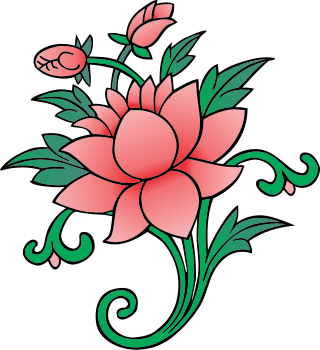
The Ratnagotravibhāga and its vyākhyā commentary, is an influential Mahāyāna Buddhist treatise on buddha-nature. The text is also known as the Mahāyānottaratantraśāstra. The RGVV was originally composed in Sanskrit, likely between the middle of the third century and no later than 433 CE. The text and its commentary are also preserved in Tibetan and Chinese translations.
The Guhyagarbha Tantra is the most important Buddhist tantra of the Mahayoga class and the primary tantric text studied in the Nyingma tradition. It is the main Nyingma source for understanding empowerment, samaya, mantras, mandalas and other Vajrayana topics, and has influenced the Dzogchen tradition. The Nyingma scholar Longchenpa sees it as "the highest summit of all vehicles, the source of all verbal transmissions, the great great shortcut of the vehicle of all Buddhas of the three times, the most secret."
Mahāyoga is the designation of the first of the three Inner Tantras according to the ninefold division of practice used by the Nyingma school of Tibetan Buddhism.
Anuyoga is the designation of the second of the three Inner Tantras according to the ninefold division of practice used by the Nyingma school of Tibetan Buddhism. This schema categorizes various stages of practice, and Anuyoga specifically emphasizes the completion stage of Tantra. As with the other yanas, Anuyoga represents both a scriptural division as well as a specific emphasis of both view and practice. Anuyoga delves into inner practices involving the subtle body, chakras, prana, nadis, and consciousness (bindu). It is particularly suited for individuals whose primary obstacle is passion and is associated with the feminine principle.
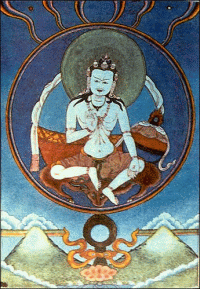
Garab Dorje was the first human to receive the complete direct transmission teachings of Sutra, Tantra and Dzogchen. The circumstances of his birth are shrouded in different interpretations, with some accounts describing a miraculous birth by a virgin daughter of the king of Uddiyana.

Sakya PanditaKunga Gyeltsen was a Tibetan spiritual leader and Buddhist scholar and the fourth of the Five Sakya Forefathers. Künga Gyeltsen is generally known simply as Sakya Pandita, a title given to him in recognition of his scholarly achievements and knowledge of Sanskrit. He is held in the tradition to have been an emanation of Manjusri, the embodiment of the wisdom of all the Buddhas.
Sri Singha was the teacher of Padmasambhava, Vimalamitra, and Vairotsana. He was a principal student and dharma-son of Mañjuśrīmitra in the Dzogchen lineage, and is credited by the Nyingma school with introducing Dzogchen to Tibet.
According to the Nyingmapa tradition of Tibetan Buddhism, the Dzogchen masters Manjushrimitra and Shrisimha were already active in the Tantric milieu in India independently. However, Manjushrimitra, a learned scholar of Brahman origin, was evidently an adherent of the Yogachara school before his becoming a disciple of the mysterious Prahevajra or Garab Dorje from the country of Uddiyana. It should also be recalled that his disciple Shrisimha was said to have born and resided for some time in China before coming to India. And that the latter's disciple Vimalamitra visited China before and after he came to Tibet and transmitted the Dzogchen teachings to his disciples at Samye Monastery.
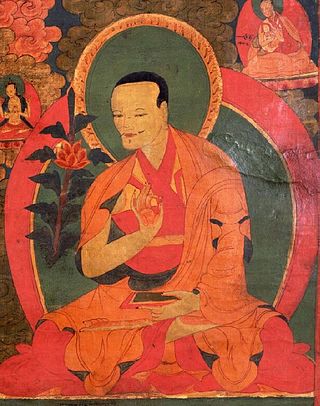
Gorampa Sonam Senge was an important philosopher in the Sakya school of Tibetan Buddhism. He was the author of a vast collection of commentaries on sutra and tantra whose work was influential throughout Tibetan Buddhism. Gorampa is particularly known for his writings on madhyamaka philosophy, especially his critique of the madhyamaka views of Tsongkhapa and Dolpopa. Gorampa defended the mainly anti-realist interpretation of madhyamaka held by the Sakya school.
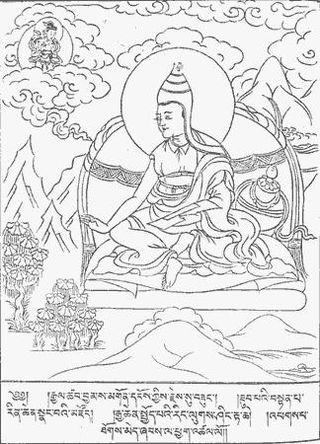
The Abhisamayālaṅkāra "Ornament of/for Realization[s]", abbreviated AA, is one of five Sanskrit-language Mahayana śastras which, according to Tibetan tradition, Maitreya revealed to Asaṅga in northwest India circa the 4th century AD. Those who doubt the claim of supernatural revelation disagree whether the text was composed by Asaṅga himself, or by someone else, perhaps a human teacher of his.
Samten Migdrön is a Tibetan text of historical importance for the historical relationship of Dzogchen and Zen as well identifying the view of its author, Nubchen Sangye Yeshe.
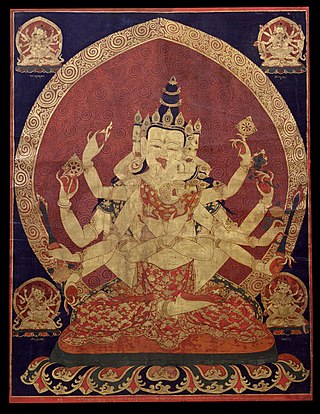
The Guhyasamāja Tantra, Tōhoku Catalogue No. (Toh) 442, also known as the Tathāgataguhyaka, is one of the most important scriptures of Tantric Buddhism, written in Sanskrit. In its fullest form, it consists of seventeen chapters, though a separate "explanatory tantra" (vyākhyātantra) known as the Later Tantra, Toh 443, is sometimes considered to be its eighteenth chapter. Many scholars believe that the original core of the work consisted of the first twelve chapters, with chapters thirteen to seventeen being added later as explanatory material.
Shentong is term for a type of Buddhist view on emptiness (śūnyatā), Madhyamaka, and the two truths in Indo-Tibetan Buddhism. It is often contrasted with the term rangtong ("self-emptiness"). The term refers to a range of views held by different Tibetan Buddhist figures.












